
- 320 pages
- English
- ePUB (mobile friendly)
- Available on iOS & Android
Introduction to the Physics of Fluids and Solids
About This Book
Written by a well-known science author, this introductory text explores the physics of solids and the field of hydrodynamics. It focuses on modern applications, rather than mathematical formalism, with particular emphasis on geophysics, astrophysics, and medical physics. Suitable for a one-semester course, it is geared toward advanced undergraduate physics students and graduate science students. It also serves as a helpful reference for professional astronomers, chemists, and engineers.
Geophysical topics include the circulation of the atmosphere, vibrations of the earth, and underground nuclear tests. Subjects related to medicine include the urinary system and blood flow, and miscellaneous topics of interest include tides, Saturn's rings, the rotation of the galaxy, and nuclear fission. Each chapter offers many vivid examples of current interest, along with 10 to 15 problems that amplify the text and apply its teachings to new situations.
Frequently asked questions
Information
Little grains of sand
Make the mighty ocean
And the pleasant land.

Table of contents
- Cover
- Title Page
- Copyright Page
- Dedication
- Contents
- Preface
- Chapter 1 Introduction to the Principles of Fluid Mechanics
- Chapter 2 Fluids in Astrophysics
- Chapter 3 The Idea of Stability
- Chapter 4 Fluids in Motion
- Chapter 5 Waves in Fluids
- Chapter 6 The Theory of the Tides
- Chapter 7 Oscillations of Fluid Spheres: Vibrations of the Earth and Nuclear Fission
- Chapter 8 Viscosity in Fluids
- Chapter 9 The Flow of Viscous Fluids
- Chapter 10 Heat, Thermal Convection, and the Circulation of the Atmosphere
- Chapter 11 General Properties of Solids—statics
- Chapter 12 General Properties of Solids—dynamics
- Chapter 13 Applications of Seismology: Structure of the Earth and Underground Nuclear Explosions
- Chapter 14 Applications to Medicine: Flow of the Blood and the Urinary Drop Spectrometer
- Appendices
- Index